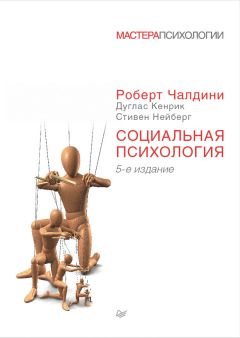Филип Зимбарго - Социальное влияние
Campbell, D. Т., and Fiske, D. W. (1959). Convergent and discriminant validation by the multitraitmultimethod matrix. Psychological Bulletin, 56, 81–105.
Campbell, D. Т., and Stanley, J. C. (1966). Experimental and quasi — experimental designs for research. Chicago: Rand McNally.
Campbell, J. D., Tesser, A., and Fairey, P. J. (1986). Conformity and attention to the stimulus: Temporal and contextual dynamics. Journal of Personality and Social Psychology, 51, 315–324.
Caplan, R. D., Robinson, E. A. R., French, J. R. P., Caldwell, J. R., and Shinn, M. (1976). Adhering to medical regimens: Pilot experiments in patient education and social support. Ann Arbor, MI: Institute for Social Research, University of Michigan.
Chaiken, S. (1979). Communicator physical attractiveness and persuasion. Journal of Personality and Social Psychology, 37, 1387–1397.
Chaiken, S. (1980). Heuristic versus systematic information processing and the use of source versus message cues in persuasion. Journal of Personality and Social Psychology, 39, 752–766.
Chaiken, S. (1987). The heuristic model of persuasion. In M. P. Zanna, J. M. Olson, and С. Р. Herman (Eds.), Social influence: The Ontario symposium (vol. 5, pp. 3–39). Hillsdale, NJ: Erlbaum.
Chaiken, S., Liberman.A., and Eagly, A. H. (1989). Heuristic and systematic information processing within and beyond the persuasion context. In J. S. Uleman and J. A. Bargh (Eds.), Unintended thought: Limits of awareness, intention, and control. New York: Guilford.
Chaiken, S., and Baldwin, M. W. (1981). Affective — cognitive consistency and the effect of salient behavioral information on the self — perception of attitudes. Journal of Personality and Social Psychology, 41, 1–12.
Chaiken, S., and Eagly, A. H. (1976). Communication modality as a determinant of message persuasiveness and message comprehensibility. Journal of Personality and Social Psychology, 34,605–614.
Chaiken, S., and Eagly, A. H. (1983). Communication modality as a determinant of persuasion: The role of communicator salience. Journal of Personality and Social Psychology, 45, 241–256.
Charen, M. (1990). Say no way: Time for good old sell — control. San Francisco Examiner, Chronicle, This World Section, p. 3.
Christiaansen, R. E., Sweeney, J. D., and Ochalek, K. (1983). Influencing eyewitness descriptions. Law and Human Behavior, 7, 59–65.
Church, G. J. (1989). The other arms race. Time, Feb. 6, 20–26.
Cialdini, R. B. (1987). Compliance principles of compliance professionals: Psychologists of necessity. In M. P. Zanna, J. M. Olson, and C. P. Herman (Eds.), Social influence: The Ontariosymposium (vol. 5, pp. 165–184). Hillsdale, NJ: Erlbaum.
Cialdini, R. B. (1988). Influence: Science and practice (2d ed.). Glenview, 1L: Scott, Foresman.
Cialdini, R. В., Cacioppo, J. Т., Bassett, R., and Miller, J. A. (1978). Low — ball procedure for producing compliance: Commitment then cost. Journal of Personality and Social Psychology, 36, 463–476.
Cialdini, R. В., and Petty, R. E. (1981). Anticipatory opinion effects. In R. E. Petty, Т. М. Ost — rom, and Т. С Brock (Eds.), Cognitive responses in persuasion. Hillsdale, NJ: Erlbaum.
Cialdini, R. В., Reno, R. R., and Kallgren, С. А. (1990). A focus theory of normative conduct: Recycling the concept of norms to reduce littering in public places. Journal of Personality and Social Psychology, 58, 1015–1026.
Clancey,M., and Robinson, M. J. (1985). General election coverage: Part I. Public Opinion, 7, 49–54, 59.
Cohen, R. E., and Syme, S. L. (Eds.) (1985). Social support and health. Orlando, FL: Academic Press.
Comstock, G., Chaffee, S., Katzman, N.. McCoombs, M., and Roberts, D. (1978). Television and human behavior. New York: Columbia University Press.
Cooper, J. (1980). Reducing fears and increasing assertiveness: The role of dissonance reduction. Journal of Experimental Social Psychology, 16, 199–213.
Cooper, J., and Fazio, R. H. (1984). A new look at dissonance theory. In L. Berkowitz (Ed.), Advances in experimental social psychology (vol. 17, pp. 229–266). New York: Academic Press.
Cooper, J.. Zanna, M. P., and Taves.P.A. (1978). Arousal as a necessary condition for attitude change following induced compliance. Journal of Personality and Social Psychology, 36, 1101–1106.
Crocker, J. (1981). Judgment of covariation by social perceivers. Psychological Bulletin, 90, 272–292.
Darley, J'. Af.,and Batson, С D. (1973). From Jerusalem to Jericho: A study of situational and dispositional variables in helping behavior. Journal of Personality and Social Psychology 27, 100–108.
Davis, 1. H. (1980). Group decision and procedural justice. In M. Fishbein (Ed.), Progress in social psychology. Hillsdale, NJ: Erlbaum.
Davis, J. H„Holt, R. W„Spitzer, С. Е., and Stasser, G. (1981). The effects of consensus requirements and multiple decisions on mock juror verdict preferences. Journal of Experimental Social Psychology, 17, 1–15.
Davis, R. M, (1987). Current trends in cigarette advertising. The New England Journal of Medicine, 316, 725–732.
DeBono, K.G. (1987). Investigating the social — adjustive and value — expressive functions of attitudes: Implications for persuasion processes. Journal of Personality and Social Psychology, 52, 279–287.
Deci, E. L., and Ryan, R. M. (1985). Intrinsic motivation and self — determination in human behavior. New York: Plenum.
Deffenbacher, K. (1980). Eyewitness accuracy and confidence: Can we infer anything about their relationship? Law and Human Behavior, 4, 243–260.
Deutsch, M., and Gerard, H. B. (1955). A study of normative and informational social influences upon individual judgment. Journal of Abnormal and Social Psychology, 51, 629–636.
DeVos.G, and Wagatsuma, H. (1966). Japan's invisible race. Berkeley: University of California Press.
Devine.P. G. (1989). Stereotypes and prejudice: Their automatic and controlled components. Journal of Personality and Social Psychology, 56,5–18..
DiMatteo, M. R., and Taranta, A. (1979). Nonverbal communication and physician — patient rapport: An empirical study. Professional Psychology 10, 540–547.
DiMatteo, R. M., Hays, R. D., and Prince, L. M. (1986). Relationship of physicians' nonverbal communication skill to patient satisfaction, appointment noncompliance, and physician workload. Health Psychology, 5, 581–594.
DiMatteo, R. M., Taranta, A., Friedman, H. S., and Prince, L. M. (1980). Predicting patient satisfaction from physicians' nonverbal communication skills. Medical Care, 18, 376–387.
DiNicola, D.D., and DiMatteo, R. M. (1984). Practitioners, patients, and compliance with medical regimens: A social psychological perspective. In A. Baum, S.E.Taylor, and J. E. Singer (Eds.), Handbook of psychology and health (vol. 4, pp. 55–84). Hillsdale, NJ: Erlbaum.
Dixon, N.F. (1971). Subliminal perception: The nature of a controversy. London: McGraw — Hill.
Dolecek, T. A., Schoenberger, J. A., Omam, J. K., Kremer, B. K., Sunseri, A. J., and Alberti, J. M. (1986). Cardiovascular risk factor knowledge and beliefs in prevention among adults in Chicago. American Journal of Preventive Medicine, 2, 262–267.
Dovidio, J. F., and Ellyson, S. L. (1982). Decoding visual dominance behavior: Attributions of power based on the relative percentages of looking while speaking and looking while listening. Social Psychology Quarterly, 45, 106–113.
Dovidio, J. F.. Ellyson, S. L., Keating, C. F'., Heltman. K., and Brown, С. Е. (1988a). The relationship of social power to visual displays of dominance between men and women. Journal of Personality and Social Psychology, 54, 233–242.
Dovidio, J. F., Brown, С E., Heltman, K., Ellyson, S. L.. and Keating, С. F. (1988b). Power displays between women and men in discussions of gender — linked tasks: A multichannel study. Journal of Personality and Social Psychology, 55, 580–587.
Eagly, A. H. (1974). Comprehensibility of persuasive arguments as a determinant of opinion change. Journal of Personality and Social Psychology, 29, 758–773.
Ebbesen, E. В., and Konecni, V. J. (1982). Social psychology and the law: A decision — making approach to the criminal justice system. In V. J. Konecni and E. B. Ebbesen (Eds.), The criminal justice system: A social — psychological analysis. San Francisco: W. H. Freeman.
Edwards, K. (1990). The interplay of affect and cognition in attitude formation and change. Journal of Personality and Social Psychology, 59,202–216.
Ekman, P. (1985). Telling lies: Clues to deceit in the marketplace, politics, and marriage. New York: Norton.
Ekman, P., and Friesen, W. V. (1969). Nonverbal leakage and clues to deception. Psychiatry, 32, 88–106.
Ekman, P.. and Friesen. W. V. (1971). Constants across cultures in the face and emotion. Journal of Personality and Social Psychology, 17, 124–129.
Ekman. P., and Friesen, W. V. (1986). A new pan — cultural facial expression of emotion. Motivation and Emotion, 10, 159–168.
Ekman, P., Friesen, W. V., and O'Sullivan, M. (1988). Smiles when lying. Journal of Personality and Social Psychology, 54, 414–420.
Elkin.R.A. (1986). Self — presentation and attitude assessment effects on cognitive processes following attitude — discrepant behavior. Unpublished doctoral dissertation, Adelphi University.
Elkin.R.A., and Leippe, M.R. (1986). Physiological arousal, dissonance, and attitude change: Evidence for a dissonance — arousal link and a «don't remind me» effect. Journal of Personality and Social Psychology, 51, 55–65.
Etlickson.P.L., and Bell, R.M. (1990). Drug prevention in junior high: A multi — site longitudinal test. Science, 247, 1299–1305.
Ellison, K. W., and Buckhout, R. (1981). Psychology and criminal justice. Cambridge, MA: Harper & Row.
Erdley, С.A., and D'Agostino, P. R. (1988). Cognitive and affective components of automatic priming effects. Journal of Personality and Social Psychology, 54, 741–747.
Erickson, В… Lind,E.A., Johnson, В. С. and O'Barr, W.M. (1978). Speech style and impression formation in a court setting: The effects of «powerful» and «powerless» speech. Journal of Experimental Social Psychology, 14, 266–279.
Eron. L. D. (1980). Prescription for the reduction of aggression. American Psychologist, 35, 244–252.
Evans, R. I. (1984). A social inoculation strategy to deter smoking in adolescents. In J. D. Mataraz — zo, S. M. Weiss, J. A. Herd, N. E. Miller, and S. M. Weiss (Eds.), Behavioral health: A handbook of health enhancement and disease prevention. New York: Wiley.
Evans, R. I., Rozelle, R. M., Maxwell, S. E., Raines, B. E., Dill, C. A., Guthrie, T. /., Henderson, A. H.. and Hill, P. С. (1981). Social modeling films to deter smoking in adolescents: Results of a three — year field investigation. Journal of Applied Psychology, 66, 399–414.
Everett. P. В., Hayward, 5. C, and Meyers, A. W. (1974). The effects of a token reinforcement procedure on bus ridership. Journal of Applied Behavior Analysis, 7, 1–9.
Exline, R. V., Ellyson, S. L., and Long. B. (1975). Visual behavior as an aspect of power role relationships. In P. Pliner, L. Krames, and T. Alloway (Eds.), Nonverbal communication of aggression (pp. 21–52). New York: Plenum.
Falbo. Т… and Peplau, L. A. (1980). Power strategies in intimate relationships. Journal of Personality and Social Psychology, 38, 618–628.
Farquhar, J. W., Maccoby, N.. and Solomon, D. S. (1984). Community applications of behavioral medicine. In W. D. Gentry (Ed.), Handbook of behavioral medicine (pp. 437–478). New York: Guilford.
Fazio, R. И. (1979). Motives for social comparison: The construction — validation distinction. Journal of Personality and Social Psychology, 37,1683–1698.
Fazio, R.H. (1987). Self — perception theory: A current perspective. In M. P. Zanna, J. M. Olson, and C. P. Herman (Eds.), Social influence: The Ontario symposium (vol. 5, pp. 129–150). Hillsdale, NJ: Erlbaum.
Fazio, R. H. (1990). Multiple processes by which attitudes guide behavior: The MODE model as an integrative framework. In M. P. Zanna (Ed.), Advances in experimental social psychology (vol. 23, pp. 75–109). New York: Academic Press.
Fazio, R. H., Sanbonmatsu, D. M., Powell, M. C, and Kardes, F. R. (1986). On the automatic activation of attitudes. Journal of Personality and Social Psychology, 50, 229–238.
Fazio, R.H., and Zanna, M. P. (1981). Direct experience and attitude — behavior consistency. In L. Berkowitz (Ed.), Advances in experimental social psychology (vol. 14, pp. 162–202). New York: Academic Press.
Fazio, R. H., Zanna, M. P., and Cooper, J. (1977). Dissonance and self — perception: An integrative view of each theory's proper domain of application. Journal of Experimental Social Psychology, 13, 464–479.




